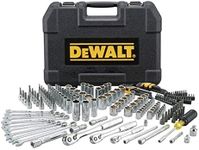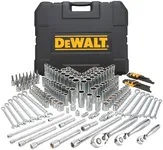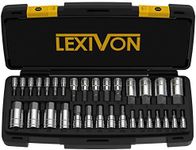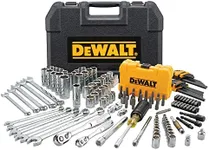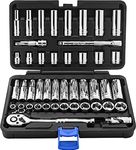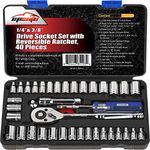Buying Guide for the Best Socket Sets
Choosing the right socket set can make your work with nuts and bolts much easier, whether you're fixing your car, assembling furniture, or tackling home repairs. The best socket set for you depends on what kind of tasks you plan to do, how often you'll use it, and the types of fasteners you'll encounter. Understanding the key features of socket sets will help you pick a set that matches your needs and ensures you have the right tools for the job.Drive SizeDrive size refers to the size of the square fitting on the ratchet and sockets, which is usually measured in inches (like 1/4", 3/8", or 1/2"). This is important because it determines the strength and size of bolts you can work with. Smaller drive sizes (like 1/4") are great for lighter, more precise work and tight spaces, while larger sizes (like 1/2") are better for heavy-duty jobs and larger bolts. If you mostly work on small electronics or bikes, a smaller drive is ideal. For car repairs or bigger projects, a medium or large drive size is more suitable.
Socket Size RangeSocket size range tells you the smallest and largest bolt heads the set can handle. This is important because you want to make sure your set covers the sizes you’ll actually use. Socket sizes are usually listed in metric (millimeters) or SAE (inches). Sets with a wide range are more versatile, but if you know you’ll only work with certain sizes, you can focus on those. Think about the types of things you’ll be working on—cars, bikes, furniture—and check what sizes are most common for those jobs.
Number of PiecesThe number of pieces in a socket set includes all sockets, ratchets, extensions, and sometimes extras like screwdriver bits. More pieces can mean more versatility, but it can also mean more tools you might not use. If you want a basic set for occasional use, a smaller set with just the essentials may be enough. If you want to be prepared for anything, a larger set with more options is better. Consider how many different tasks you want to tackle and choose a set that matches your needs.
Material and FinishSocket sets are usually made from steel, and the finish (like chrome or black oxide) helps prevent rust and wear. This is important for durability and long-term use. Higher-quality materials and finishes last longer and are less likely to round off bolts or break. If you plan to use your set often or in tough conditions, look for sets with strong materials and protective finishes. For occasional home use, standard materials are usually fine.
Point Type (6-point vs. 12-point)Sockets come in different point types, mainly 6-point and 12-point. This refers to the number of corners inside the socket that grip the bolt. 6-point sockets grip bolts more securely and are less likely to slip, making them better for heavy-duty work. 12-point sockets are easier to fit onto bolts in tight spaces because they have more angles to catch on, but they may slip more easily under heavy force. If you need maximum grip for tough jobs, go with 6-point. If you want convenience for lighter work, 12-point may be better.
Accessories IncludedMany socket sets come with accessories like extension bars, universal joints, or adapters. These extras help you reach bolts in awkward places or use your sockets with different tools. This is important if you expect to work in tight or hard-to-reach spots. If your projects are straightforward, you may not need many accessories. But if you want maximum flexibility, look for sets with a good selection of extras.
Case or StorageA good case or storage system keeps your sockets organized and easy to find. This is important for convenience and making sure you don’t lose pieces. Some cases are sturdy and portable, while others are basic. If you plan to carry your set around or store it in a garage, a strong, well-organized case is a big plus. For home use, a simple case may be enough.



